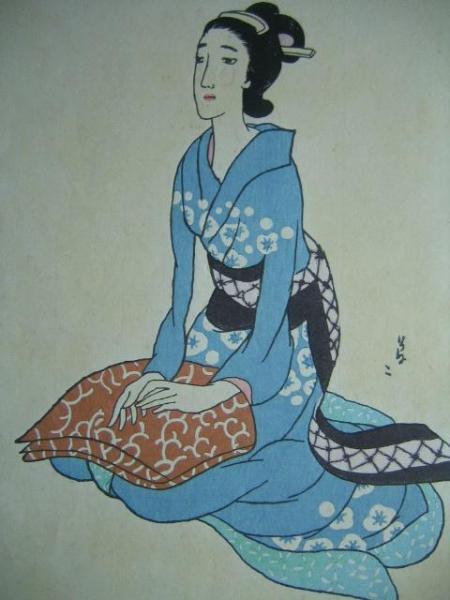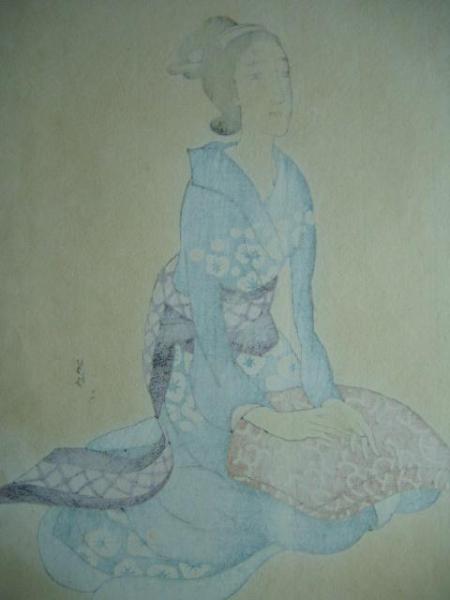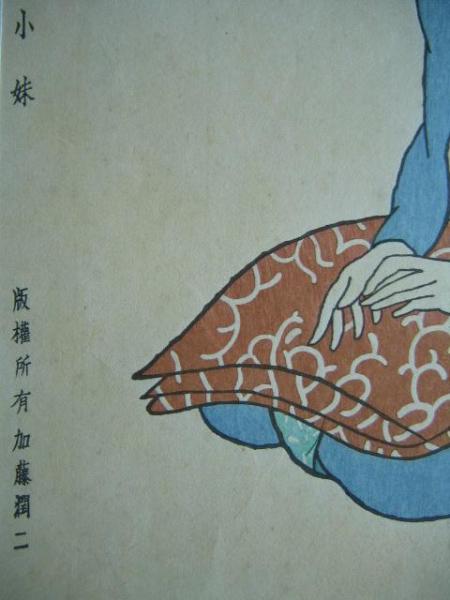| | |
| Artist: | Takehisa Yumeji (1884-1934) — 竹久夢二 |
| Title: | Younger Sister — 故小妹 |
| Series: | Yumeji Masterpieces — 夢二名作集 |
| Date of first edition?: | Not set |
| Publisher (first edition)?: | Kato Junji |
| Publisher (this edition)?: | Kato Junji |
| Medium (first edition): | Woodblock |
| Medium (this edition): | Woodblock |
| Format (first edition): | Not Set
|
| Format (this edition): | Not Set |
| DB artwork code: | 39962 |
| Notes (first edition)?: |
|
| Notes (this edition)?: |
| The following information was taken from the original web listing of this artwork. Note that there may be some inaccuracies:
Tuesday, 26 December 2006
木版画シート、刷込み(夢二 故小妹 版権所有加藤潤二)、紙、ヤケ小・シミ小・状態普通、33.8x25.7、竹久夢二(夢二式情緒の美人画、岡山、昭和9年51歳没)、オリジナル版画です。 |
|
| Series Information: |
| The majority of Yumeji's woodblock-printed designs were released after his death in 1934. The publisher who was instrumental in having Yumeji's work recognized was the Tokyo-based Katō Junji (1885-1961). During the late 1930s and early 1940s. Katō and his team of artisan block-cutters and printers at the Katō Print Workshop (Katō Print Workshop) (Katō Hanga Kenkyūjo) reused and recalled numerous famous paintings, music scores and watercolours for series of prints and postcards. The thirty woodblock prints in this set are a selection of the most popular cover designs from the over 270 that the artist produced of Seno music scores. Katō Junji personally compiled the set and it reflects what he believed was representative of Yumeji's artistic diversity, ranging from the portrayal of beautiful women and landscapes to this fascination with Western artistic styles. (from The Lavenberg Collection of Japanese Prints). |
|
| Artist Bio: |
Takehisa Yumeji (1884-1934) was a leading figure in the Taisho Romanticism movement that combined Western romanticism with native Japanese styles during the Taisho Period (1912-1926). He was a painter, writer, poet, bookbinder and illustrator whose drawings of women with thin bodies and large eyes filled with melancholy were known as Yumeji Bijin-ga. During the height of his popularity he was called the “modern Utamaro” and the Japanese “Toulouse-Lautrec and Edvard Munch”. His prints epitomized the relationship between popular art and the woodblock.
|
|




